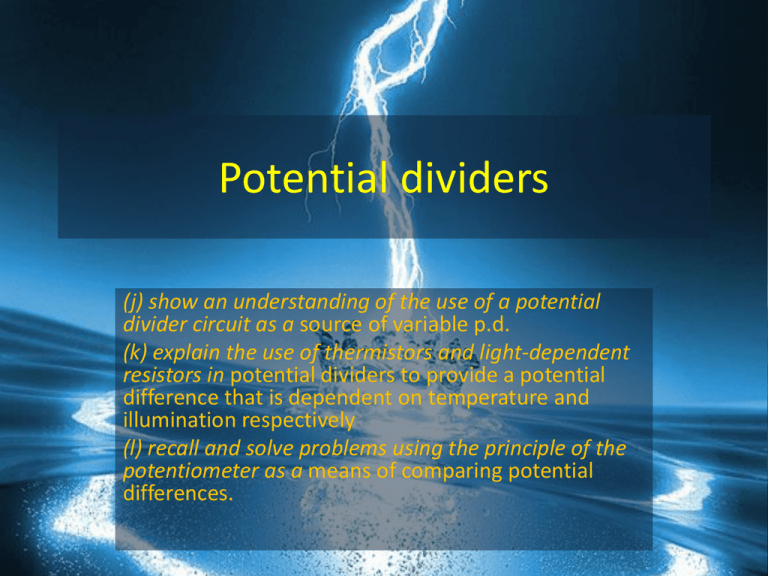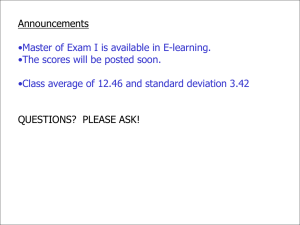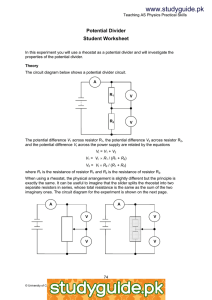File - SCIS PHYSICS
advertisement

Potential dividers (j) show an understanding of the use of a potential divider circuit as a source of variable p.d. (k) explain the use of thermistors and light-dependent resistors in potential dividers to provide a potential difference that is dependent on temperature and illumination respectively (l) recall and solve problems using the principle of the potentiometer as a means of comparing potential differences. Combining Resistors In series • The first diagram shows three resistors connected in series • There are 3 facts that you should know for a series circuit: – the current through each resistor in series is the same – the total p.d., V across the resistors is the sum of the p.d.s across the separate resistors, so: V = Vl + V2 + V3 – the combined resistance R in the circuit is the sum of the separate resistors Equivalent resistance • Suppose we replace the 3 resistors with one resistor R that will take the same current I when the same p.d. V is placed across it • R = Rl + R2 + R3 • We know that for the resistors in series: • V = Vl + V2 + V3 • But for any resistor: p.d. = current x resistance (V = I R). • If we apply this to each of our resistors, and remember that the current through each resistor is the same and equal to I, we get: • IR = IRl+IR2+IR3 • If we now divide each term in the equation by I, • we get: • R = R1 + R2 + R3 In parallel • We now have resistors connected in parallel: • There are 3 facts that you should know for a parallel circuit: – the p.d. across each resistor in parallel is the same – the current in the main circuit is the sum of the currents in each of the parallel branches, so: – I = I 1 + I2 + I3 • the combined resistance R is calculated from the equation: 1/R=1/R1+1/R2 ……. • Suppose we replace the 3 resistors with one resistor R that takes the same total current I • When the same p.d. V is placed across it. • I = I1+I2+I3 • But for any resistor, current = p.d. = resistance (I = V/R ). • If we apply this to each of our resistors, and remember that the • p.d. across each resistor is the same and equal to V, • we get: V/R=V/R1 + V/R2 + V/R3 • Now we divide each term by V, to get: • 1/R=1/R1 + 1/R2 + 1/R3 You will find that the total resistance R is always less than the smallest resistance in the parallel combination. Ideal ammeters • In order to measure the current, an ammeter is placed in series, in the circuit. • What effect might this have on the size of the current? • The ideal ammeter has zero resistance, so that placing it in the circuit does not make the current smaller. • Real ammeters do have very small resistances - around 0.01 Ω. Ideal voltmeters • A voltmeter is connected in parallel with a component, in order to measure the p.d. across it. • Why can this increase the current in the circuit? • Since the voltmeter is in parallel with the component, their combined resistance is less than the component's resistance. • The ideal voltmeter has infinite resistance and takes no current. • Digital voltmeters have very high resistances, around 10 MΩ, and so they have little effect on the circuit they are placed in. A potential divider • The potential divider is one of the most useful circuits • Calculate the voltage across each of its resistors. • For an unloaded potential divider the current through each resistor is the same so the voltage is proportional to the resistance. • This means that the pd across the pair of resistors is divided in the same ratio as the resistors themselves: R2 V2 VS R1 V1 The potential divider formula • • • • V1 / V2 = I R1 / I R2 or V1 / V2 = R1 / R2 if R1 >> R2 then V1 is more or less the supply voltage • If R1 << R2 then V1 is close to 0 V. • You could look at VS as an input to the potential divider and V1 as an output. • The circuit itself provides a way to tap off a voltage between 0 V and VS. R2 V2 VS R1 V1 Using a Rheostat • This can, of course be done continuously using a rheostat or potentiometer • Observe a variety of these • Rotary potentiometers are used as volume controls in hi-fi systems. VIN VOUT Using a Rheostat • • • • • • V1 = IR1 Vs=IR1+IR2 Vs=I(R1+R2) V1/Vs= IR1 /I(R1+R2) V1/Vs= R1 /(R1+R2) The potential divider equation can be derived by rearranging the ratios to give: • V1 = R1 / (R1+R2) VS R2 V2 VS R1 V1 To Do • Carry out the experiment • Complete the worksheet • Written report and answers due next lesson Null methods • A B is a length of wire • C is a moveable contact • G is a galvanometer • E is a source of emf Calibration • Using a standard cell (known emf) • C is adjusted until Galvanometer reads zero • At this point the circuit is balanced (p.d. across AC = emf). • The length AC is measured • Emf / L gives a value in Vm-1 • The circuit is calibrated Measuring emf • Place unknown emf at E • Find balance point as before • Measure length from A to C (L) • Multiply L by callibration factor to find unknown E. Extension - The effect of the load on output • What is the effect of loading a potential divider on its output voltage. • Connecting a load across R1 reduces the output voltage. • This is because the effective resistance in the lower arm of the potential divider is now a parallel combination of R1 and R load (less than R1) so a smaller fraction of the voltage is ‘tapped off’. • If Rload >> R1 then there is no significant effect on the output voltage. • Consider what is happening when a lit bulb goes out when “shorted out” by a piece of wire. • Avoid using a current based explanation • Think in terms of potential difference, and resistance. • In the “shorting out” case it was not that “all the current wanted” to take the easier parallel route”, but that the low resistance of the wire in parallel reduced the combination’s total resistance, compared to the rest of the circuit. Extra task • Further worksheet for the keen and able









